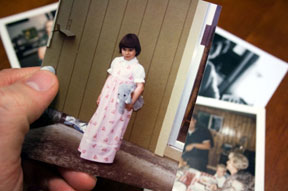t memoir workshops and conferences, eager people with bright faces rush up and tell me about their personal stories. “I have to write this. I have to get it out of me!” Then, they get serious. “There’s so much to tell, I don’t know where to start!” I love hearing their juicy stories, but they have so many questions.
- Where should I begin?
- How can I decide how much to include? (There’s so much.)
- How do I know if my memories are accurate?
- What if my family disagrees with my memories? Should I change my writing to please them?
- My family does not agree with my point of view about the truths I have to tell, and they don’t want me to write. What should I do?
What is a memoir? A memoir is an artful combining of significant events into a dramatic narrative that creates an emotional response in the reader.
Memories are like dreams—fleeting—like silver fairies floating in the mind. When you write a memoir, you need to feel permission to explore your memories and write the truths you want to tell. Most memoirists have been journaling for years, capturing their experiences and feelings and trying to chase away the inner critic that questions what they are doing. It’s important to argue with it, then push it aside with daily affirmations to begin writing your memoir. Remember, your story is your truth, no one else’s. Write what you remember; write your own story. Create a safe, sacred place where you can write, and keep your writing private. That way, you don’t have to defend your memories or your truths, and you can write freely. Give yourself permission to hear your own voice.

“The growth and change of the main character is imperative in any story and is the primary reason a memoir is written...”
From Journaling to Story
We begin thinking about our memories in terms of incidents. “First I went to the store. Then the car swerved, I found myself in the hospital, and my mother visited me. The next day, I got a cast; and at school, everyone signed it, and then...” Beginning memoirists tend to write in an episodic way—‘‘this happened, then that happened, and after that...’’ The transition from ‘‘so many interesting things happened to me’’ to choosing and shaping your narrative based on your theme and focus needs to take place to have a story. In the example above, if you realize your theme is “how I learned that a bad thing can turn out good when I was eight,” it will help you choose the details that help your story come alive.
Unlike journaling, a story has a form—a beginning, middle, and an end; and what’s called a “hook”—the way that you’re invited into the story. To draw your reader in, you can use action, beautiful language, or interesting characters. Read the first two pages of ten novels and memoirs. Notice when you want to keep reading and when you’re not interested. What did the author do to draw you in, and how did the author lose you?
What is a story?
- Something significant happens in each scene of the story—the point of the scene.
- A story has a reason for being told—your theme.
- The main character, the protagonist—in a memoir, it’s you!—is changed significantly by events, actions, decisions, and epiphanies. The growth and change of the main character is imperative in any story and is the primary reason a memoir is written—to show the arc of character change from beginning to end.
- The form of story is beginnings, conflict, rising action, a crisis, a climax, and a resolution. In a memoir, begin with a situation, a problem, something that is off-kilter in your world. For instance, if your memoir is about abuse, you might begin with a scene showing the abuse, then go back to show other aspects of your life, including the good moments.
- By the end, the story world, the world where the protagonist began, is transformed, and you have undergone profound change. If there was loss, for instance, by the end, you have confronted your fears and come to a new place with your problem. Some people call this the journey of the hero; but for us, it’s our journey through the dark woods as a heroine trying to find herself.
Fictional Tools, Turning Points, and the Timeline
Writing a memoir is a balancing act between writing our truths and using fictional tools, such as sensual details and scene, to create a world. The first task is to find the significant moments, the important messages that are part of your theme, and shape your book around them. This begins to sketch the spine of your plot and the arc of your story.
To clarify your choice of theme for your narrative arc, ask the following questions:
- What is the main, dominant meaning of my story?
- What is my book about? (One sentence)
- How does my book end? What do I want the reader to understand and learn?
To locate the answers to these questions, find your important emotional turning points and plot them along a timeline. As you discover the 10 to 20 significant moments of change, you will begin to see themes emerge. First, make a list of these turning points, keeping in mind that they need to be “big moments,” when something significant changed for you. They might be very different kinds of moments, some ecstatic joy and soaring happiness and others profound sadness, confusion, or grief.
On a large sheet of paper, draw a long, horizontal line to represent time, and mark your birth about one-fourth of the way along that line. In this way, you can note the events that you might want to write that occurred before your birth—stories of family, parents, or grandparents—the lore that you picked up through eavesdropping at holidays or family picnics!
Divide the horizontal line into sections that represent decades, and chart the years of each decade along the horizontal line. Begin to locate your turning point events along your timeline.
In my workshops, there is always an “aha” when doing this exercise. Thinking about significant turning points can be illuminating and provides new insights. When people see events laid out on the timeline, they start seeing how certain events clustered, or how some events were closer to or further away from another one. The emotional impact of the timeline exercise is powerful. There’s nothing like an image representing the important moments of our lives to offer new ways of seeing our lives.

“The first task is to find the significant moments, the important messages that are part of your theme, and shape your book around them.”
Themes
What news are you delivering in your memoir? What are the points you will make—these questions help answer the bigger question, “What is my book about?” When we start writing, we may not know our theme; we’re still marinating in the memories and details of our lives and stories. When we explore the turning point moments and muse again about why we are writing a memoir, theme begins to rise up like mountains at the edge of the plains. This is often an unconscious process, and we need to write more stories before theme becomes clearer.
An example of theme, Lit by Mary Karr, is the third volume of her trilogy of memoirs. It’s about her recovery from alcoholism through finding religion and many other things, too—the early stages of her literary life, her husband, son, and friends. She writes with new insights about her family and deeper reflections on the stories in The Liar’s Club. The arc of the book is a journey from her being lost in alcohol to becoming sober and finding herself. When you read it, notice the significant moments that she’s decided to share, and how we are able to follow her through the book to see how some of these moments are resolved. And notice her unique style and language. You have your own style and voice, which you’ll develop as you keep writing.
Frank McCourt’s Angela’s Ashes is about his poverty stricken childhood in Ireland. The arc of his story begins with his earliest memories and ends with leaving to come to New York. There are other themes, too—the Catholic Church, his mother Angela, his abandoning father, and dying, starving siblings. In terms of turning points, you can see that he includes significant events that shift the plot into new directions, each one adding a new trajectory to the story. Of course, his voice is unique, redolent with the flavors of Ireland.
Learn to Write Scenes
A scene takes place at a particular moment in time and uses sensual details—smell, sound, texture, description, color, and taste. A scene brings us into your world, as you develop characters, dialogue, and action. A story writing cliché is important here: “Show, don’t tell.”
Telling: ‘‘He was generous, confident, and likable.’’
Showing: ‘‘He threw down a five-dollar bill for the cup of coffee, winked at the waitress, and walked out, his coattails swinging.’’
It’s a challenge to expose deeply personal material. Follow a painful memory with a happier one to keep your emotional balance.
In a memoir, there are times when we sit back and reflect, narrating or narrating too much—telling what happened instead of showing it. This is the single most common reason for a story or a memoir to be rejected by an agent or publisher, so it’s important to learn how to write scenes. There are many books on writing, including my Power of Memoir, and books on fiction writing that will teach you how to write a scene. It’s important to read—memoirs or fiction—any well written work will have scenes that bring the world of the characters to life.
When we write a scene, we find ourselves in the past in a kind of creative hypnosis. Scenes link together the action of the story and delineate the characters. Yes, you as the protagonist are a character in the story; and at the same time, the narrator that guides the reader through the story.
Got Plot?
Memoirists ask me if they really need a plot. After all, isn’t what happened in their life already a plot? Not necessarily. For one thing, we know that a memoir is a focused story about a topic, not your whole life.
A plot is a series of dramatized events that show how characters encounter obstacles and challenges, and how they solve their problems. These events are written in scenes that show action and character development. Dramatic structure, the narrative arc, is a mythic structure, a deeply satisfying resolution that fits with our need to create pattern and perspective in the midst of chaos of real life. This is one reason why memoir is so challenging—we are trying to create a story out of chaos, to make sense of the irrational and nonsensical impulses that drive all human beings. When you lift your own significant plot moments out of the confusion, you’ll have the basic spine of your story.
A memoir brings the light of our own consciousness and our reflections to the simplicity of the episodic structure that’s often the first draft of a memoir. When you create your plot and become aware of your themes, you offer readers a unique perspective, shining your creative, artistic light on “reality”, so they can be inspired and transformed by your story.

“When you create your plot and become aware of your themes, you offer readers a unique perspective, shining your creative, artistic light on “reality”, so they can be inspired and transformed by your story.”
Three Acts of the Narrative Arc
The arc of the narrative can be divided into act one, two, and three, the usually invisible structure of a book, play, or movie. In act one, the characters are introduced, the story problem is set up, and we’re drawn into the world of the story.
In act two, the characters’ problems become more muddled and complex, shown through scenes of actions and reactions that highlight the characters’ journeys toward change and transformation—all the while trying to solve the problems that were presented at the beginning of the book. Since real life gets complicated, the way that plot works is imitated by life. Or is it the other way around?
In act three, the threads and layers of complexity reach a peak—the crisis and climax of the story. Here the character is tested, where the true depth of learning and transformation is revealed. The crisis may be thought of as a spiritual challenge or a “dark night of the soul,” where the deepest beliefs and core truths of the character are tested. The climax is the highest level of tension and conflict that the protagonist must resolve as the story comes to a close. There’s an aha at the end, an epiphany when the main character has learned her lessons and can never return to the previous way of living.
Becoming Heroines
The real plot of our lives for women is the heroine’s journey. We leave our “regular” safe world to go out and wander through dark forests and parched deserts, all the while yearning for guidance and home. The heroine is called to a search—Cinderella searches for a way to go to the ball, but really, she is searching for a way out of a life of cruelty and neglect. She’s lucky to have a fairy godmother. But perhaps, your wise guide is Gandalf or a therapist or teacher; perhaps, she’s a grandmother or a good friend. While we’re on the journey, forces conspire to keep us moving forward, rather than back, to the familiar life we wish for; and on this journey, we learn our spiritual lessons. We learn to be brave and to keep going, and we learn how to become stronger in the weak places.
Understanding our own story—how we are heroines and naming the heroes and heroines in our own lives—helps us deepen our connection with magic and with our spiritual potential to blaze a trail with our story, inspiring others with our courage. I keep telling my students that writing is an act of courage, so...
Be brave, and write your story!
***
Linda Joy Myers, Ph.D., MFT, is the President and founder of the National Association of Memoir Writers, Instructor at Writer’s Digest, past president of the California Writers Club, Marin branch, and former Vice President of the Women’s National Book Association. She’s the author of The Power of Memoir—How to Write Your Healing Story, and the award-winning memoir Don't Call Me Mother. Her first book Becoming Whole: Writing Your Healing Story has been used as a text by therapists, ministers, and writing coaches, and was a finalist in the ForeWord magazine’s 2008 Book of the Year Award.
Linda Joy has won prizes for her work in fiction, non-fiction, and poetry, and her next book is Truth or Lie: On the Cusp of Memoir and Fiction. She presents workshops nationally, and helps people capture their stories through coaching, editing, and ongoing online workshops. Visit her blog, Memories & Memoirs.
-----
Enjoyed this article? Check out these related articles on WOW!:
Creating Scenes
Drawing from Life to Create Your Story & List of Universal Themes in Memoir
People are Characters Too: A Guide for Bringing the People in Your Memoir to Life
Finding Innocence and Experience: Voices in Memoir
Journal Writing: Making It Personal
Using Setting and Description in Creative, Yet Crucial Ways
20 Questions with Natalie Goldberg on Memoir Writing
20 Questions with Judith Barrington on Memoir Writing